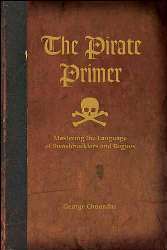The History of Maritime Piracy
Cindy Vallar, Editor & Reviewer
P.O. Box 425, Keller, TX 76244-0425
Cindy Vallar, Editor & Reviewer
P.O. Box 425, Keller, TX 76244-0425
|
|
|
|
|
|
Books for Adults - Nonfiction

The Pirate Primer: Mastering the Language of
Swashbuckers and Rogues
By George Choundas
Writer’s Digest Books, 2007, ISBN
978-1-58297-489-7, US $19.99 / CAN $24.99
![]()
![]()
![]()
![]()
![]()
In 1995 two guys – John Baur and Mark Summers – decided we needed a day devoted to pirates. Thus Talk Like a Pirate Day was born. But how exactly did pirates talk? What words and phrases did they use? How did they put a sentence together? Did they follow ordinary rules of grammar, or did they make them up? Unfortunately, no one ever bothered to write a book that answered these questions.Until now!
George Choundas, a lawyer and former FBI agent, wondered the same thing. While visiting Tampa Bay, he and his wife visited a costume store. The pirate behind the counter confessed to frequently charging “out the door after tourists” and harassing “them nine different kinds of pirate-like, then calmly [he] steps back into the shop and resumes his business.” George thought that had “to be the best job in the world.” But how?
Most of us might ignore that niggling question. George did not. He just had to know. To that end he read forty-one books, watched twenty films and thirteen television shows, and visited the most famous of all pirate exhibits – Disney’s Pirates of the Caribbean – to find out how to talk like a swashbuckling rogue who preyed on ships traversing the Caribbean during the Golden Age of Piracy. Figuring someone else might like to know what he knew, George then wrote The Pirate Primer so everyone in the pirate community might learn to talk like a pirate.
Divided into two parts and twenty-two chapters, this primer has everything you might possibly want to know. There are greetings and partings, calls and flourishes, commands and threats, oaths and curses, insults and epithets, respectful ways to address someone, retorts and contractions, questions and replies, and toasts and declamations. He devotes a full chapter to the most famous of all pirate words, Arrgh! (Did you know this word has 44 definitions?) Chapter 16 covers cultural terms related to piracy, the company and crew, arms, torture and punishment, food and drink, currency, time, distance and other measurement units, and women. And that’s just Part I. The second part covers the nitty-gritty: pronunciation, the wrong way to talk, how to convert English into pirate speak, how to form a sentence, and parts of speech. Each entry in these two parts includes pronunciations, meanings, explanations, and samples from the various sources he studied. Each chapter also begins with an introduction that often includes events in pirate history. The final section of the book includes three appendices. The first provides you with openers, middlers, and closers to help you create your own pirate speak, while the second appendix covers the sounds these rogues often made while talking. The final one is a sampling of articles of agreements from fictional pirates (Copley Banks and Peter Blood) and real buccaneers (Edward Low, William Kidd, George Lowther, Henry Morgan, John Phillips, Bartholomew Roberts, and Woodes Rogers).
I don’t make it a habit of reading primers cover to cover unless I have to (read: the teacher insisted), but that’s what I did with George’s book and every page was a treasure to savor. The combination of words, facts, quotes, and explanations provides readers with a wealth of information. If you study The Pirate Primer*, you’re guaranteed to be able to talk like a pirate next time September 19th comes around. If you’re a writer, your characters’ dialogue will come alive and sound more realistic. This is an essential tool for anyone interested in maritime piracy. More valuable than gold or silver, you will guard this book closely, for many pirates will be searching for this treasure the next time they go a plunderin’.
To sweeten the riches found within the pages of The Pirate Primer, the publishers invite ye to try yer hand in decipherin’ clues to win $1000 in authentic coins to fill yer own treasure chest. Entries must be received by 31 August 2007. To learn more, visit The Pirate Primer Treasure Hunt. And may the best pirate win!
*Note to English teachers: “The real rule of pirate grammar is that there are no rules.”
Book Review Copyright ©2007 Cindy Vallar
Home Pirate Articles Pirate Links Thistles & Pirates